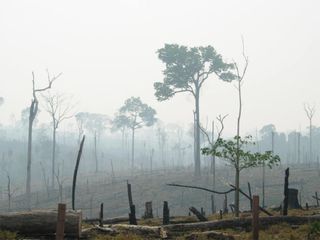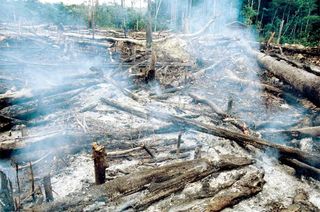Amazon Due for Numerous Species Extinctions

When species lose their natural habitat to deforestation and other causes, they don't immediately disappear. Instead, they gradually die off over several generations, racking up an "extinction debt" that must eventually be paid in full. New research shows that the Brazilian Amazon has accrued a heavy vertebrate extinction debt, with more than 80 percent of extinctions expected from historical deforestation still impending.
While the results are alarming, this deathly time lag provides a conservation opportunity to save some of the disappearing species, scientists said, stressing that actions taken in the next few years are critical.
"Now that we know where the extinction debt is likely to be, we can go to the ground to restore habitat and take remedial actions to try to regenerate new habitats," said study lead author Robert Ewers, an ecologist at Imperial College London in the U.K. "We can try to put off ever having to pay that debt."
Extinction debt
The Brazilian Amazonis home to about 40 percent of the planet's tropical forests and a staggering amount of biodiversity. However, the Amazon's plant and animal species are under threat by deforestation, mostly due to agriculture and cattle ranging. [Stunning Photos of the Amazon]

Ewers and his colleagues set out to determine how many species would be lost from at least part of their historical habitats in the Amazon because of past and future deforestation. They began by looking at the "species-area relationship," a well-established ecological pattern describing how the number of species in a given habitat increases predictably as the habitat area increases. By turning this idea on its head, you can figure out how many species should go extinct as their habitat shrinks.
The researchers modeled the number of vertebrate species expected to go extinct within 31-mile by 31-mile blocks (50 by 50 kilometer blocks). They used a combination of deforestation data spanning back to 1970 and species-distribution maps of the Amazon. They compared their model's predictions with the actual number of extinctions seen thus far in the forest regions and found that 80 to 90 percent of the expected local extinctions have yet to happen, and many of them will occur in the southern and eastern regions of the Amazon.
Sign up for the Live Science daily newsletter now
Get the world’s most fascinating discoveries delivered straight to your inbox.
Next, Ewers and his team used their model to estimate the magnitude of the local extinctions and extinction debts expected to occur in four scenarios, which mainly differ in their projections of future deforestation rates. Under the most likely scenario, every forest block will lose an average of about nine vertebrate speciesand be in debt for another 16 species by 2050.

And in all scenarios, species will continue to go extinct more than three decades after deforestation in the Amazon has stopped, if key forest areas are not restored, the researchers found.
"What we've seen in the last four decades is nothing like what we are going to see in the next four decades," Ewers told LiveScience.
Defaulting on the debt
Thiago Rangel, an ecologist at the Federal University of Goiás in Brazil who wasn't involved in the research, was surprised to see the Amazon's huge extinction debt. "Of course, that gives Brazil a very good opportunity for conservation measures," Rangel said. [10 Species You Can Kiss Goodbye]
Rangel, who wrote a perspective article accompanying the study published July 13 in the journal Science, pointed out that Brazil has made a lot of progress in reducing deforestation in the last decade. Moreover, the county has been expanding its network of protected areas — more than 50 percent of the Amazon is now under some form of environmental protection.
"But we are in the middle of a strong transition in Brazil from a very good and modern environmental legislation to something else," Rangel told LiveScience. Agricultural businesses, for example, have been lobbying for weaker forest protection codes — this past May, Brazilian President Dilma Rousseff vetoed portions of such a bill, though this isn't likely the end of the debate, Rangel said.
Rangel stresses that Brazil must "default on its extinction debt," possibly by creating more conservation areas, particularly in places that have been abandoned by agriculturalists. Whatever the case, something needs to be done soon, he said.
Ewers agreed. "This problem has been building, and it will soon roll over and crash like a wave," he said.
Follow LiveScience on Twitter @livescience. We're also on Facebook & Google+.

Most Popular


